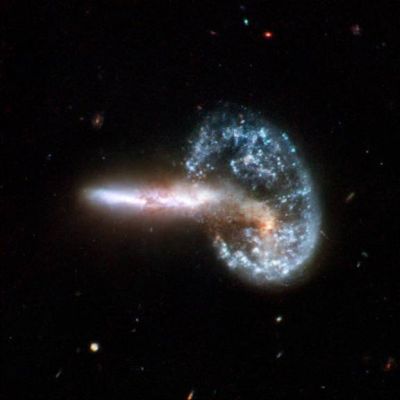29 April 2008

Credit: NASA, ESA, the Hubble Heritage (STScI/AURA)-ESA/Hubble Collaboration, and A. Evans (University of Virginia, Charlottesville/NRAO/Stony Brook University)
Celebrating the 18th anniversary of the launch of the Hubble Space Telescope (HST), NASA has published a new collection of HST’s incredible images, showing stunning collisions between galaxies.
One of the images shows a colliding pair of galaxies designated Arp 148. Due to the powerful gravitational interaction through the collision, one of the galaxies is now ring-shaped; its companion was so deformed that it has a long tail of material.
The ring was formed due to the shockwave effect, created during the collision. The elongated companion perpendicular to the ring indicates that Arp 148 is a unique case of an ongoing collision. Infrared observations reveal a strong obscuration region that appears as a dark dust lane across the nucleus in visual light.
Arp 148 is located in the constellation of Ursa Major, the Great Bear, and approximately 500 million light-years away. This interacting pair of galaxies is included in Arp's catalog of peculiar galaxies as number 148.
In its 18 years of exploring the cosmos, HST has snapped more than 540,000 images of 27,000 celestial objects. Hubble does not journey through the Universe; it takes pictures of the cosmic splendors as it circles Earth at approximately 28,000 km per hour.
The telescope has completed 100,000 orbits around Earth. During these orbits, Hubble has traveled a cumulative distance of approximately 4 billion km, which is equivalent to a round trip to Saturn. Every month, the orbiting observatory generates more than 70 gigabytes of data, enough information to fill 70 complete sets of encyclopedias.
Further Reading
Hubble Press Release
http://hubblesite.org/newscenter/archive/releases/2008/16/image/
Aymen Mohamed Ibrahem
Senior Astronomy Specialist